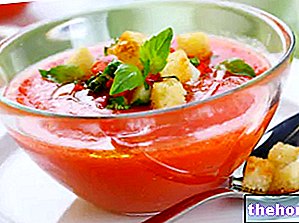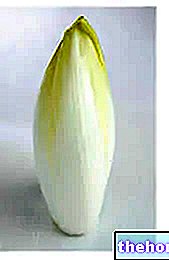Carrots in history
The name "carrot" derives from the Greek "Karotòn", while in botany it is known as "Daucus carota ".
Probably, the typical yellow-orange color of carrots is due to a mutation of a mauve-colored species. Although its origins lie in the East, where it has been cultivated for thousands of years, the ancient Greeks and Romans already used carrots, not so much for culinary use (due to the typical woody and hard texture of the vegetable), but as medicinal plants. .
Botanical analysis

The edible part of the carrot is the root, whose average length can vary from 3 to 20 cm, although there are varieties that even reach 90 cm. The diameter of the root can vary, as a rule, from 1 to 6 cm.
The carrot is considered a weed, very common in meadows and, in this case, has a less developed and shorter root.
Nutritional properties
As for the nutritional properties, the carrot is configured as a real mine of minerals: iron, calcium, magnesium, copper, zinc. But not only that: the carrot provides pro-vitamin A (carotenoids), vitamins B and C; of all vegetables it represents the richest source of beta-carotene, transformed into vitamin A by the body in case of need. Just think, in fact, that 200-300 grams of carrots provide a quantity of beta-carotene equal to about 5- 10 times the recommended daily requirement (20-25 mg compared to an estimated requirement of 2-4 mg / day).
Carotene is the pigment responsible for the typical orange color of carrots: precisely for this reason, carotenes are extracted from the root and used as a natural dye in the agro-food industry (E160).
Carrot root is rich in sugar reserves, while in the herbaceous part there are many flavonoids, furanocoumarins and oil with low molecular weight molecules: a very volatile oil, which is characterized by the content in geraniol, limonene, and sesquiterpenes such as daucolo.
Carrot essential oil in cosmetics
Carrot seed oil is extracted by steam distillation and is widely used in perfumery, to ignite fresh and sweet notes: it is also widely used for its very low cost. In the cosmetic sector, carrot essential oil, combined with carotenes, it is also used for the formulation of tanning and anti-aging creams and in products that stimulate hair growth. In addition, the cosmetic industry provides for the use of carrot pulp for the treatment of burns, boils, dry and chapped skin, and to heal wounds.
Carrot in herbal medicine
The fresh carrot root can also be used for the decoction: in this way it can exert diuretic and expectorant properties, to counteract cough and hoarseness. Instead, by replacing the carrot seeds with the fresh root, you can obtain a decoction that promotes proper digestion. The carrot could be of help in the regularization of intestinal functions and in carrying out a soothing action for the digestive system.
Other properties are also linked to the carrot: it could be exploited for its diuretic and carminative abilities, to alleviate ailments such as stones, cystitis and urinary problems.
Carrot puree is used as a remedy for diarrhea, especially in children.
However, attention must be paid to the use of carrot seed oil: the side effects on the central nervous system could be similar to those caused by barbiturates. However, this effect was only demonstrated in vitro.
To make the most of the potential of the carrot, it would be good to eat it raw, without removing the peel; it would also be advisable to clean the outside with a brush to remove any harmful substances and microorganisms.
Nutritional values
The table shows the nutritional values per 100 grams of carrots, based on the Food Composition Data Bank for Epidemiological Studies in Italy
Edible part 95%
Vitamins
Minerals
Energy Kcal 35
Water 91.6 g
Thiamine 0.04 mg
Sodium 95 mg
Energy KJ 147
Protein 1.1 g
Riboflavin 0.04 mg
Potassium 220 mg
Carbs available 7,6g
Niacin 0.70 mg
Iron 0.7 mg
Starch 0 g
Vitamin C 4 mg
Calcium 44 mg
Soluble carbohydrates 7.6 g
Vitamin A 1148 μg
Phosphorus 37 mg
Dietary fiber 3.1 g
Vitamin E 0
Magnesium 11 mg
Total lipids 0.2 g
Zinc 2.92 mg
Cholesterol 0 g
Copper 0.19 mg
Selenium 1.0 μg
Tradition teaches
Among the remedies to combat gastritis, in ancient times carrots played an important role: the vegetable sauce of raw carrots, drunk slowly, seemed to soothe abdominal pain and counteract irritation at the level of the gastric mucosa.
In the distant Middle Ages, the roots of carrots were considered "miraculous" remedies: the green part boasted, even then, used in the treatment of kidney stones.
Since ancient times, the carrot was used to promote tanning and to combat diarrhea in childhood.
Carrot and almond cake without butter for celiacs
Carrot and almond cake without butter for celiacs
Problems with playing the video? Reload the video from youtube.
- Go to the Video Page
- Go to the Video Recipes Section
- Watch the video on youtube
Other Foods - Vegetables Garlic Agretti Asparagus Basil Beets Borage Broccoli Capers Artichokes Carrots Catalonia Brussels sprouts Cauliflower Cabbage and Savoy cabbage Red cabbage Cucumber Chicory Turnip greens Onion Sauerkraut Watercress Edamame Chives Chanterelles Flour Cassava Flowers Pumpkin Flour Edible Flowers Pumpkin Seasonal Fruits and Vegetables Endive Salads and Salads Strengthening Salad Lettuce Aubergines Vegetables Nettle Pak-Choi Parsnip Potatoes American Potato Peppers Pinzimonio Tomatoes Leeks Parsley Radicchio Turnips Red Turnips Radishes Rocket Shallots Endive Celery Celeriac Seeds Sprouted Spinach Truffle Valianamberi or Jerusalem artichoke laxatives Saffron Pumpkin Zucchini Vegetables - Nutritional properties OTHER VEGETABLE ITEMS Categories Food Alcoholics Meat Cereals and derivatives Sweeteners Sweets Offal Fruit Dried fruit Milk and derivatives Legumes Oils and fats Fish and fishery products Cold cuts S pezie Vegetables Health recipes Appetizers Bread, Pizza and Brioche First courses Second courses Vegetables and Salads Sweets and Desserts Ice creams and sorbets Syrups, liqueurs and grappa Basic preparations ---- In the kitchen with leftovers Carnival recipes Christmas recipes Light diet recipes Women's Day, Mum, Dad Recipes Functional Recipes International Recipes Easter Recipes Recipes for Celiacs Recipes for Diabetics Recipes for Holidays Recipes for Valentine's Day Recipes for Vegetarians Protein Recipes Regional Recipes Vegan Recipes



















-nelle-carni-di-maiale.jpg)








